
¡Hola, amigos! Hoy quiero compartir con ustedes una historia muy inspiradora, ocurrida hace muchos años, pero que hoy en día todavía sigue moviendo fibras en millones de personas alrededor del mundo. Ponte cómodo y prepárate para conocer como 16 muchachos fueron capaces de sobrevivir a las inclemencias del hambre, la nieve, el dolor y el miedo, luego de dos meses varados en un implacable glaciar de los andes.

El 12 de octubre de 1972, un grupo de jóvenes del colegio Old Christians de Uruguay, partió rumbo a Chile para participar en un partido de Rugby, en el vuelo 572 de la fuerza aérea uruguaya. El avión Fairchild F-227, lo abordaron 40 pasajeros entre los jóvenes rugbistas y algunos amigos y familiares que los acompañaban, en total eran 45 personas junto con los cinco tripulantes.

Al poco tiempo de haber salido de Uruguay, tuvieron que aterrizar en Mendoza, Argentina, debido al mal tiempo. Al día siguiente las condiciones climáticas no habían mejorado mucho, pero les urgía llegar a Chile sin perder el tiempo, así que decidieron continuar el viaje de todos modos. Los chicos estaban muy felices, tomando fotografías. Algunos, incluso viajaban por primera vez en avión.

Había muchísimo viento, lo que provocó que los pilotos se desorientaran. A las 3:20 de la tarde, el piloto informó al control aéreo chileno que estaban sobrevolando el Paso del Planchón, pero realmente estaban encima de la cordillera de los andes.
Los chicos, sin saber lo que estaba a punto de suceder, bromeaban a propósito de la turbulencia del viento que sacudía al avión, levantaban los brazos y reían, otros se asomaban a las ventanillas para ver las blancas montañas, sorprendidos porque nunca habían visto la nieve.
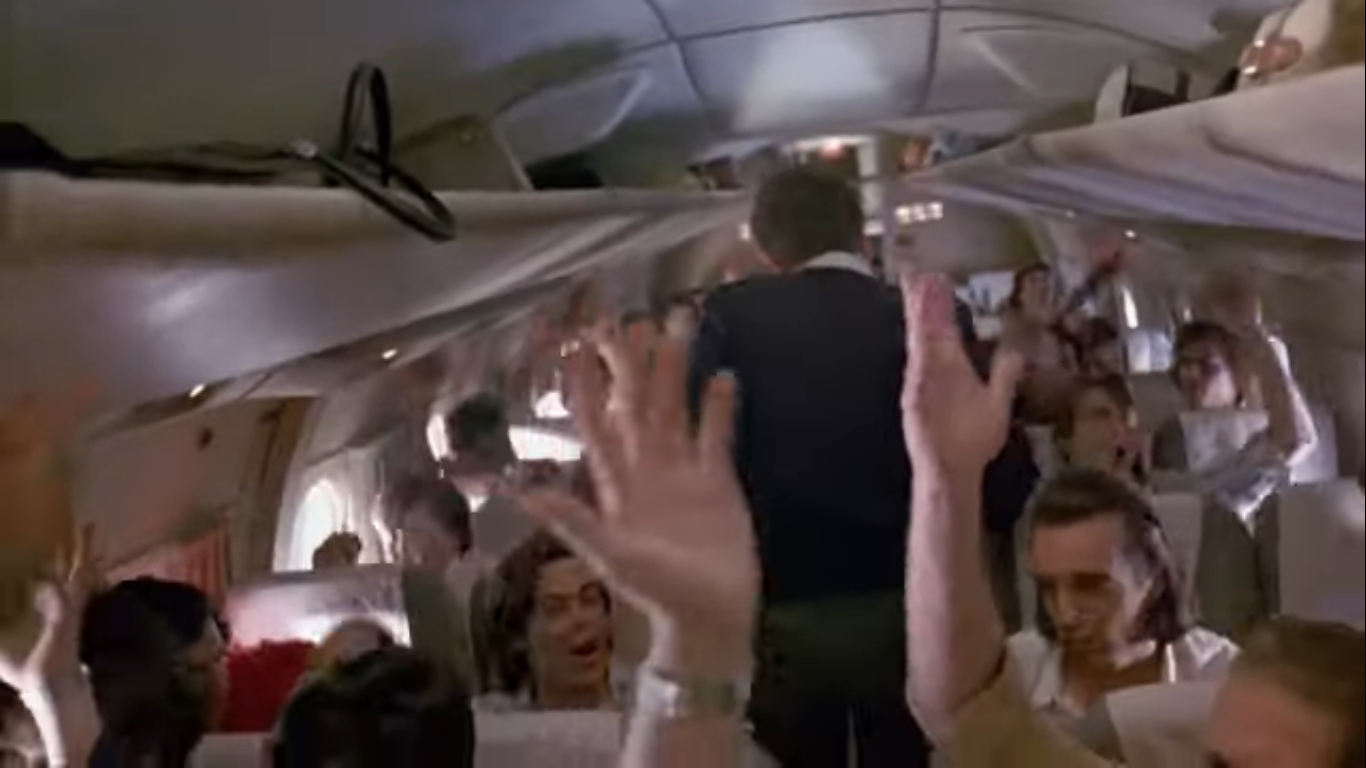

Debido a la información dada por el piloto, la torre de control dio la orden de aterrizaje, al creer que estaban cerca del aeropuerto, no obstante, cuando el piloto comenzó a descender el avión, no pudo ver nada a causa de la niebla, pasando muy cerca de los picos de las montañas. El avión perdió mucha más altura mientras se sacudía con violencia a causa de las turbulencias provocadas por los llamados «pozos de aire». Algunos de los pasajeros estaban asustados, pero la mayoría de los jóvenes rugbistas seguían bromeando y cuando la niebla se disipó, pudieron comprobar que las montañas estaban mucho más cerca que antes.

El avión se dirigió sin remedio hacia el pico de una montaña y a pesar de que el piloto hizo lo posible por evitar la colisión, fue imposible que la cola del avión impactara, y el ala derecha también impactó contra otra parte de la montaña, partiéndose de inmediato, al igual que la cola.
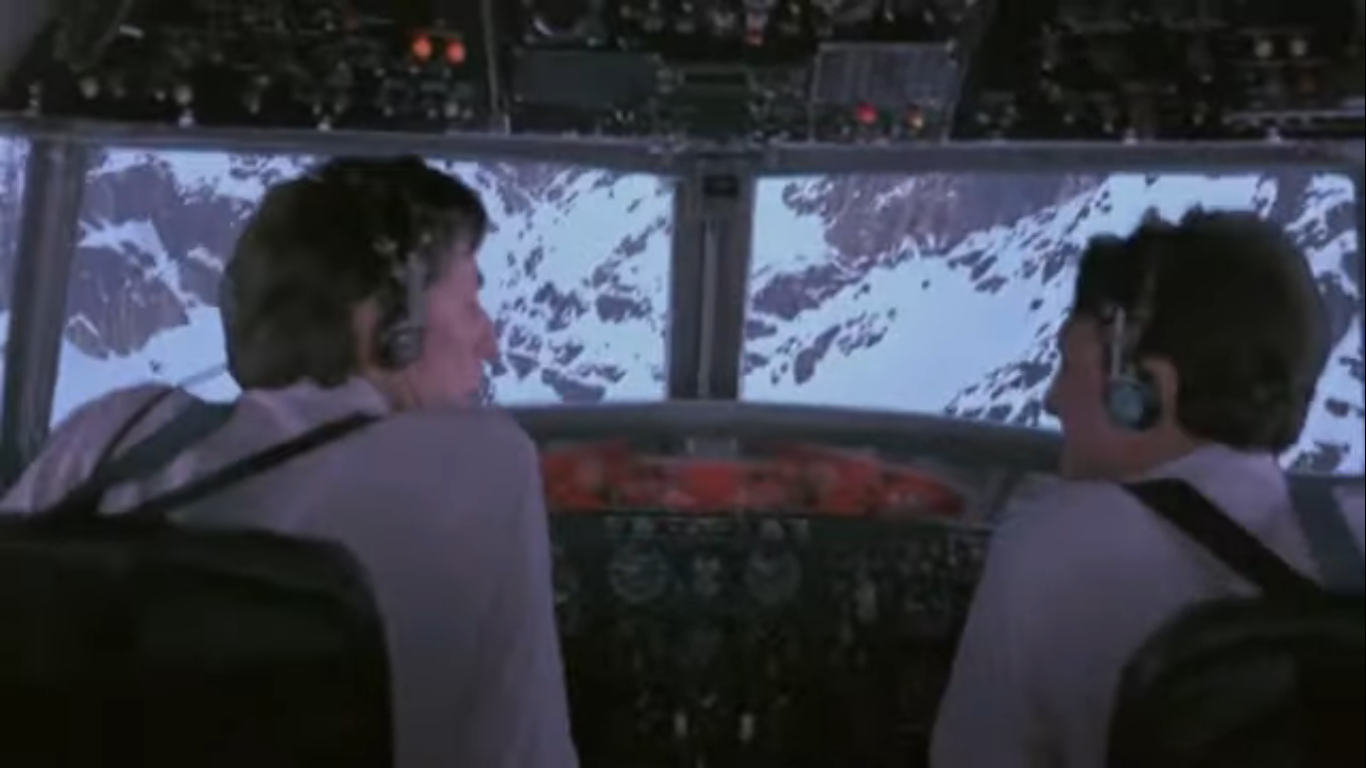
Inmediatamente una fuerte ráfaga de aire helado entró en el avión y succionó a siete pasajeros, arrojándolos fuera del avión.
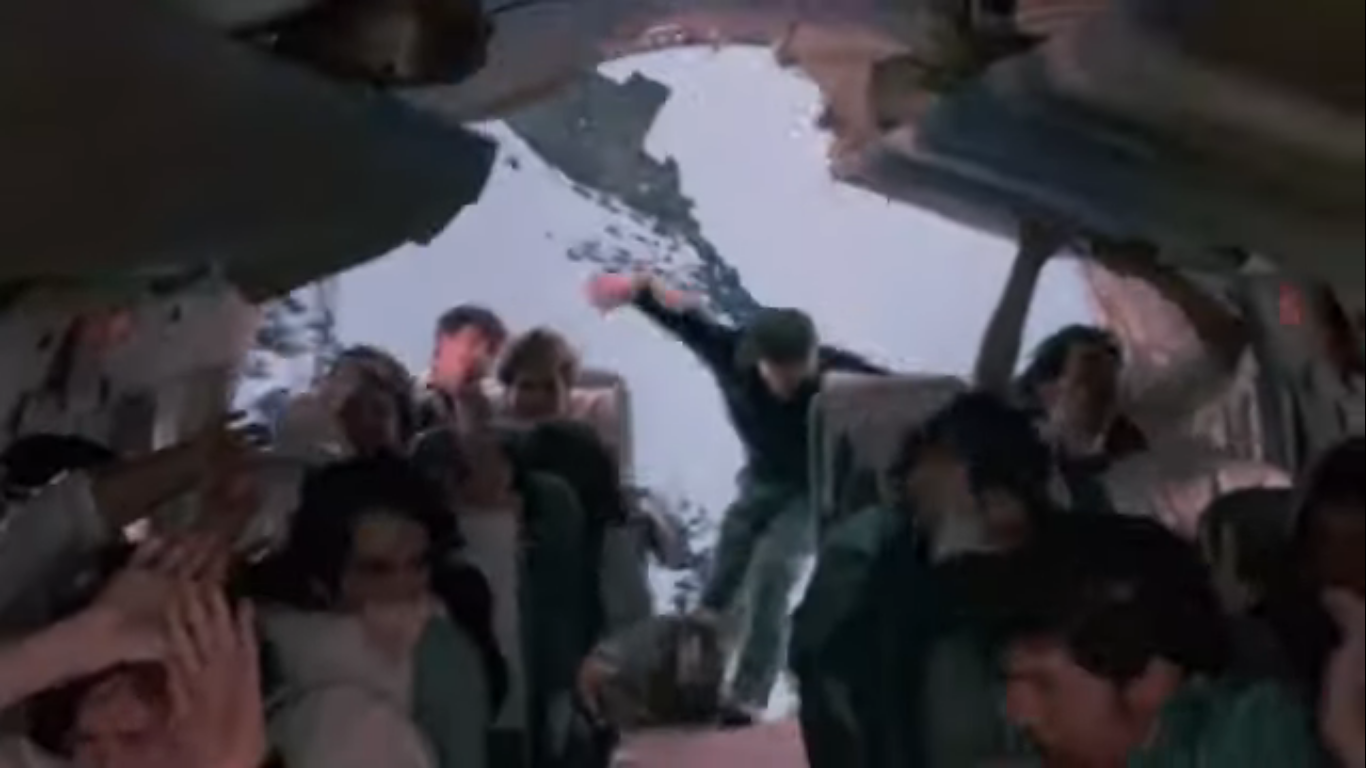
Como el avión estaba totalmente fuera de control, impactó otra montaña y perdió el ala izquierda. El fuselaje, que parecía más bien un tubo gigante, comenzó a descender por una pendiente nevada a gran velocidad, entre gritos de pánico y dolor.


Carlitos Páez (uno de los sobrevivientes) cuanta que en ese momento, mientras el avión descendía a gran velocidad, comenzó a rezar la oración del Ave María, y justo cuando dijo la última frase, el movimiento se detuvo. Aún así le llevó un poco de tiempo asimilar que estaba vivo y sobre todo, que estaba ileso, aunque su amigo (que viajaba a su lado) estaba muerto. Carlos no podía creer que minutos antes su amigo le había pedido cambiar de puesto con él porque quería ver las montañas desde la ventanilla.
Al detenerse, el avión impactó con violencia un banco de nieve. En ese impacto murió el piloto instantáneamente junto con otros pasajeros. Roberto Canesa (otro de los sobrevivientes) cuenta que recuerda como la fuerza del impacto lo empujó contra el asiento delantero, haciéndolo perder la consciencia por unos minutos.
Él dice que cuando despertó del desmayo, enseguida comenzó a escuchar gritos de auxilio y de dolor desde todas partes, además se estremeció a causa del intenso frío que entraba desde el enorme boquete que había dejado la cola del avión al desprenderse. Algunos pasajeros estaban atrapados bajo los asientos, otros tenían heridas por todas partes o huesos rotos. No obstante, Canesa, entre otros, solo habían sufrido heridas leves, así que comenzaron a ayudar a los heridos, usando agua de colonia como desinfectante.
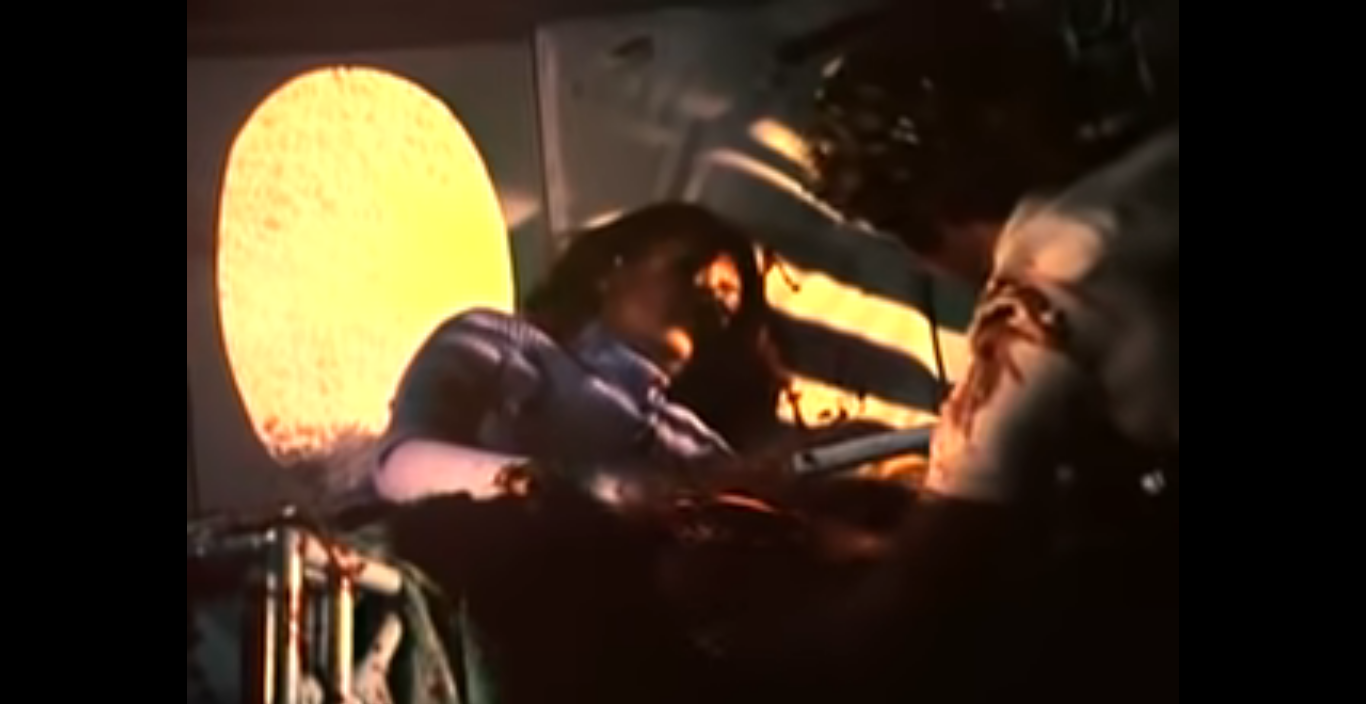
El frío era muy intenso, así que se abrigaron como pudieron con la ropa que encontraban en el equipaje de mano, y esa misma noche bloquearon el boquete usando el equipaje y asientos, para que no entrara la ráfaga de aire que los estaba matando de frío.
Todos estaban muy desorientados, sin saber donde estaban, así que uno de los sobrevivientes fue hasta la cabina y descubrió que el piloto estaba muerto, sin embargo el copiloto estaba vivo, aunque muy grave, aún así les dijo que estaban ubicados en Curicó porque estaba convencido de ello, aunque estaba equivocado. Al poco tiempo, el copiloto murió.
Los días siguieron pasando, y las personas que estaban gravemente heridas fueron muriendo, mientras Roberto Canesa, junto con otro de los sobrevivientes que estaban estudiando apenas el primer año de medicina, hacían todo lo posible por ayudarlos.
La primera noche para ellos fue como el infierno, en medio de gritos, quejas y ese intenso frío que no los dejaba respirar. Había menos 30 grados de temperatura, y los días sucesivos, aunque pudieron tapar el boquete y no entraban las ráfagas de aire, igualmente hacía mucho frío. El capitán del equipo de rugby, inmediatamente tomó el liderazgo de los demás, pidiéndoles que recolectaran todo lo que llevaban de comida, como enlatados, dulces y otros aperitivos para poder racionarlos, ya que no sabían cuando serían rescatados.
El segundo día de su abrupta llegada a la cordillera, vieron pasar dos aviones que probablemente los estaban buscando, pero estaban volando demasiado alto, así que no pudieron verlos.
Uno de los sobrevivientes, Roy Harley, encontró en su equipaje, su cámara de fotos, entonces se dedicó a documentar todo lo acontecido capturando imágenes de cada momento


Al principio se alimentaban con un pequeño pedazo de chocolate diario que les suministraba el líder del equipo, y un trago de vino, pero luego de varios días la escasa comida se acabó. No obstante, ellos se organizaron e idearon un sistema precario pero efectivo para derretir la nieve, usando una placa de aluminio que encontraron entre la chatarra del avión, de esta forma podían recolectar hasta dos litros de agua diario.
Uno de esos días, se dieron cuenta de que Fernando Parrado a quién creían muerto porque no se movía, realmente estaba vivo, aunque su madre había muerto, y su hermana estaba agonizando. Desde el momento en que él despertó, se dedicó a cuidar de ella hasta que finalmente murió y le tocó sacarla del avión para enterrarla bajo la nieve, junto con los demás cadáveres.
Un día, alguien encontró una pequeña radio entre los asientos, pero no funcionaba, así que le pidieron a Roy Harley (que estaba en primer año de ingeniería) que intentara repararla y afortunadamente lo logró. De esta forma consiguieron captar una señal donde escuchaban noticias, incluso las que anunciaban los detalles de la búsqueda de los sobrevivientes del vuelo 571, pero lamentablemente, luego de varios días escucharon que la búsqueda se canceló porque creían que ya no habría sobrevivientes y además, por más que buscaban no podían hallar los restos del avión.
En ese momento se dieron cuenta de que ahora dependían exclusivamente de ellos mismos y su capacidad para no rendirse, alguien tenía que salir desde el refugio del avión para buscar ayuda porque además la poca comida que tenía ya se había terminado. Era necesario encontrar alimento, pero no había vegetación, ni animales que cazar por ninguna parte, era solo nieve por todos lados. Entonces, en un arrebato de desesperación Fernando Parrado hizo un comentario que en ese momento nadie tomó demasiado en cuenta.
«Si seguimos así, creo que me comeré al piloto, al fin y al cabo fue él quien nos metió en esta situación»
Pero el tiempo pasaba y el hambre cada vez era más atroz, aunado a la sensación de impotencia de que ya no estaban siendo buscados por nadie, de esta forma comenzaron a analizar su situación y también la única opción que les quedaba... los cadáveres.
Todos eran jóvenes cristianos y por lo tanto les resultaba muy difícil la idea de recurrir a la antropofagia como medio de supervivencia, se sentían primitivos e incapaces, pero no había más opción que esa. Por lo tanto, entre todos hicieron un pacto: Si alguno de ellos moría, los demás podrían tomar su cuerpo como fuente de alimento. Todos estuvieron de acuerdo, pero Fernando Parrado insistía en que no tocaran los cadáveres de su madre y hermana, pues le resultaba terriblemente difícil la sola idea de alimentarse de sus seres queridos.
De modo que, comenzaron a extraer algunos cadáveres que habían enterrado en la nieve y empezaron a cortar pequeñas tiras de carne, aunque les resultó terriblemente difícil, no solo por el pudor, sino porque la carne estaba muy congelada. Posteriormente pusieron los pequeños trozos de carne sobre el fuselaje del avión para intentar secarlos y finalmente, comenzaron a alimentarse de ellos. Todos coinciden que al principio fue terrible, incluso sintieron arcadas, pero con el tiempo comenzaron a acostumbrarse.

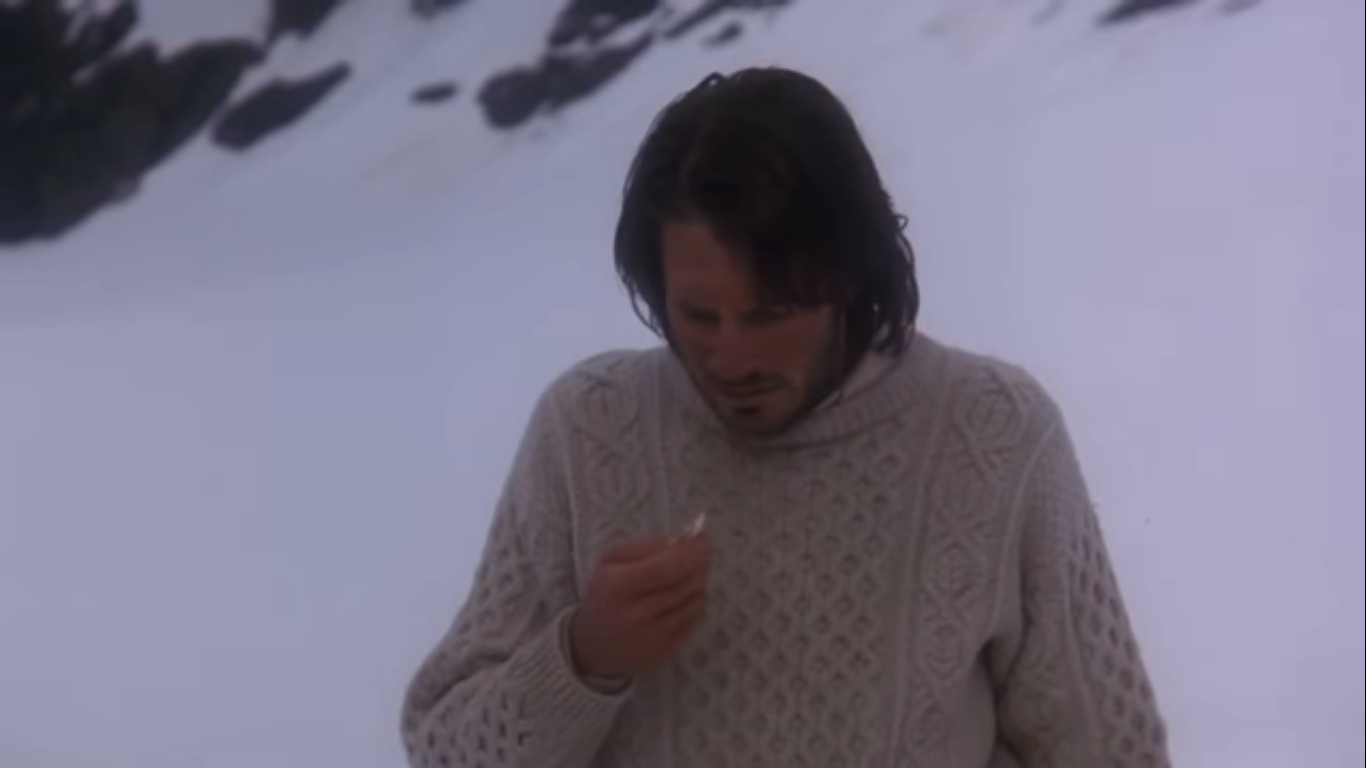
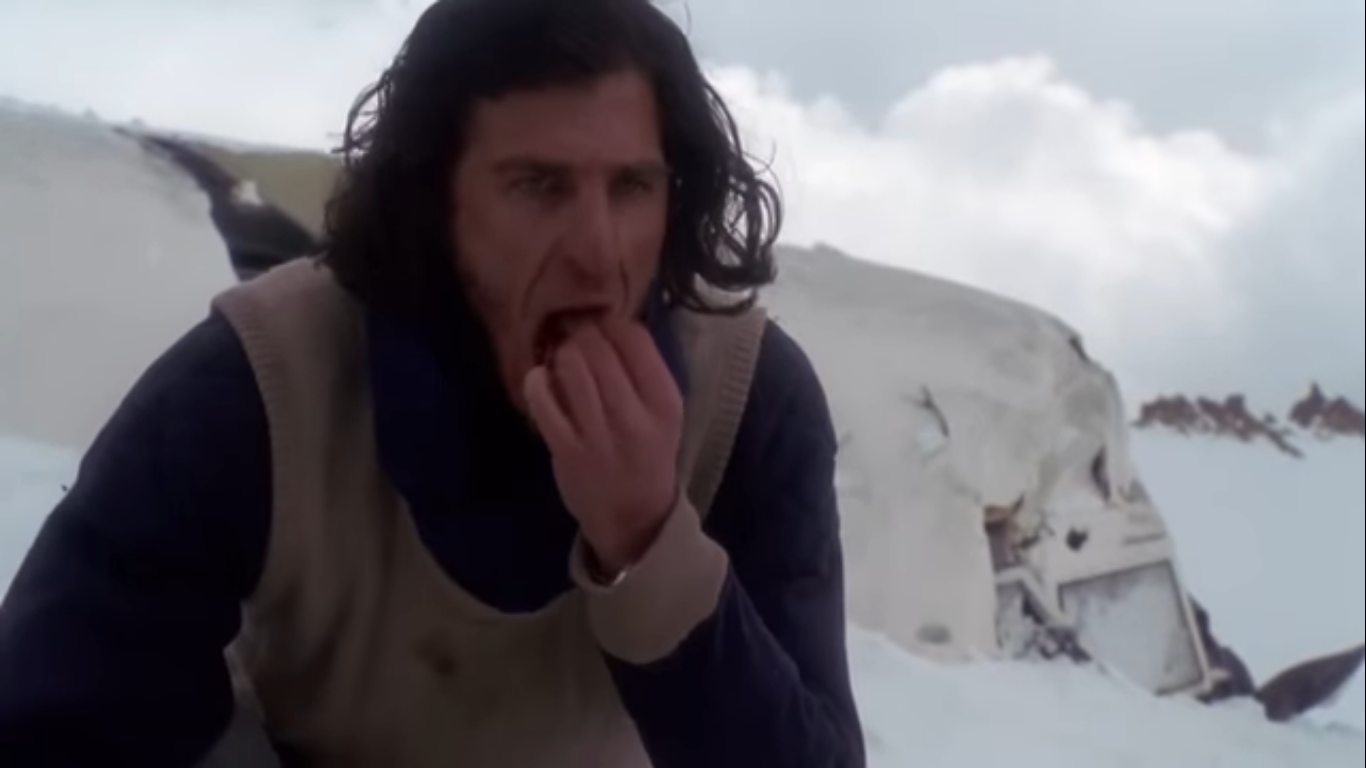
La idea era reunir fuerzas para poder viajar más lejos, ya que en días anteriores habían intentado encontrar la cola del avión, pero el hambre, el frío y el cansancio los había dejado fuera de combate muy rápido.
Lamentablemente, 17 días después del accidente, una terrible avalancha de nieve cayó sobre el fuselaje del avión, sepultándolos a todos y matando a algunos de ellos, incluyendo a la única mujer que había sobrevivido hasta ese momento (la esposa de uno de ellos)
En ese momento. Roy Harley logró quitárse la nieve de encima, y al verse completamente solo, comenzó a desenterrar con desesperación a sus compañeros, descubriendo que algunos estaban muertos y otros habían logrado sobrevivir. Los que habían logrado salir de la nieve, ayudaron a Roy a rescatar a los demás. Ocho personas fallecieron ese día, entre ellos, Marcelo Perez, el capitán del equipo de Rugby, quien había tomado la iniciativa de racionar la poca comida que tenían.
En noviembre murieron dos personas más, a causa de la gangrena que proliferaba en sus heridas. El día 60 desde la llegada a la cordillera, murió la víctima número 29. Se agotaba el tiempo, tenían que salir a pedir ayuda. De todas las 45 personas que habían abordado el avión, ya solo quedaban 16.
Todos decidieron que Roberto Canesa, Viszintin y Fernando Parrado, serían los encargados de hacer la nueva expedición para intentar buscar ayuda, de modo que Canesa había Fabricado una precaria pero funcional bolsa de dormir, usando las fundas de los asientos y un poco de material aislante.
Los tres abandonaron el fuselaje del avión el 12 de diciembre, el día 61 desde el accidente, se fueron armados con la bolsa de dormir, agua y carne para los tres. No obstante, dos días después comprendieron que el camino que tenían por recorrer era mucho más sinuoso de lo que imaginaban pues, detrás de la gran montaña que habían subido, no había praderas como habían creído, sino más montañas, así que decidieron que Vizintin regresara al refugio del avión, dejándole su ración de comida y agua a los otros dos que continuarían el viaje.
Pero antes de irse, Fernando Parrado, le dijo a sus amigos que si no tenían más opción, entonces podían tomar los cuerpos de su madre y su hermana para alimentarse.

Roberto Canesa y Parrado escalaron montañas aunque estaban exhaustos, caminaron largas distancias, durmieron a la intemperie, pero a pesar de todo, Canesa recuerda que se consolaba con la vista de los amaneceres y atardeceres, porque en ellos encontraba la presencia de Dios y la motivación que necesitaba para seguir adelante.

Luego de días de viaje, finalmente, Roberto y Fernando dejaron de ver nieve y el ambiente se hizo más cálido, por lo que, la carne que les quedaba pronto comenzaría a descomponerse, por lo tanto decidieron enterrarla, en lugar de simplemente arrojarla, ya que se trataba de carne humana, algo que los había mantenido con vida.
Luego de diez días de caminata, finalmente Roberto y Fernando vieron una vaca, y más adelante a un hombre al otro lado de un río. Esa era su salvación, así que comenzaron a hacer señas y a gritar, pero el ruido que hacía la corriente del río no permitía que se entendiera lo que decían.
El hombre era Sergio Catalán, un arriero que había llevado a sus animales a pastar en ese lugar. Al ver que esos muchachos intentaban comunicarse con él, el hombre les arrojó una piedra en la que estaban atados una hoja de papel y un bolígrafo. Entonces Fernando Parrado escribió algunas líneas, explicando que ambos venían de un avión que cayó en las montañas, que estaban hambrientos y cansados, y que habían dejado al resto de sus amigos (14 personas) en los restos del avión. Volvió a atar el papel y el bolígrafo a la piedra y se la arrojó de vuelta al arriero.

Sergio Catalán entonces les arrojó unos cuantos panes con queso que llevaba consigo y les hizo entender por medio de señas que volvería con ayuda y así fue, el hombre cabalgó diez horas hasta llegar al lugar donde encontró la ayuda y los guió de regreso a donde estaban Roberto y Fernando.

Finalmente, Fernando Parrado se fue con el equipo de rescate en un helicóptero para guiarlos hasta donde estaban sus amigos en las montañas. Aquí les dejaré las imágenes del rescate, es un momento muy emocionante.
Fueron momentos muy duros y difíciles, pero nos demostraron muchas cosas: en primer lugar que la vida puede cambiar en un segundo para nosotros y podemos perder todo lo que tenemos, hallándonos en la más absoluta miseria, es entonces cuando descubres de que estás hecho, puedes sentarte a esperar la muerte, pasar lo que te reste de vida quejándote, o llenarte de determinación y seguir luchando hasta el último momento.
Los chicos de los andes descubrieron, en medio de la soledad, que no había más opción que ayudarse los unos a los otros para juntar fuerzas, que eran mucho más fuertes de lo que creían y que Dios les había otorgado vida a través de la muerte de sus compañeros, para que de allí en adelante se dedicaran a ayudar a otros, así como el arriero Sergio Catalán los rescató de una muerte segura.
Estos son los sobrevivientes luego de 47 años desde el accidente, aunque lamentablemente uno de ellos murió el año pasado.

Roberto Canesa se convirtió en un gran medico que se dedicó especialmente a la cardiología prenatal, y escribió un libro maravilloso llamado «Tenía que sobrevivir», del cual extraje mucha información para la realización de este post. Yo escuché el audiolibro y se los recomiendo.
Fernando Parrado se convirtió en un gran presentador de televisión pero también escribió un libro y se dedica a dar conferencias motivacionales, al igual que Roy Harley.

Desde que tuve más conocimientos acerca de esta maravillosa e inspiradora historia, siempre quise ponerme en contacto con alguno de los sobrevivientes y finalmente lo logré en el año 2019, cuando tuve la dicha de recibir una respuesta por parte de Roy Harley en un correo electrónico.
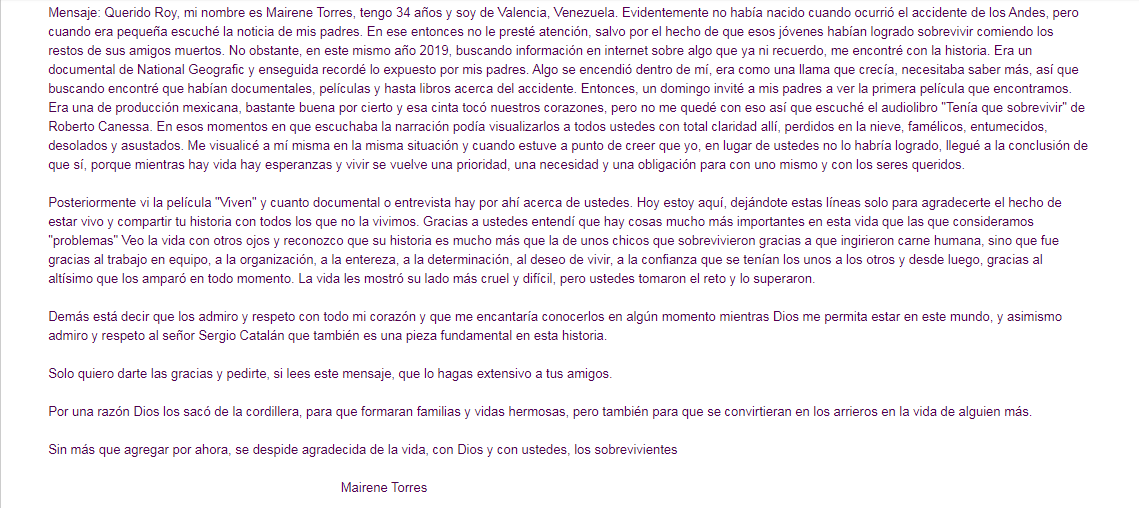


Muchas gracias por toda su atención, amigos, espero que se hayan sentido tan motivados como yo después de conocer esta historia. Nos vemos en una próxima oportunidad.
.jpg)
.jpg)
Hello, friends! Today I want to share with you a very inspiring story, which happened many years ago but today is still pulling at the heartstrings of millions of people around the world. Get comfortable and get ready to know how 16 boys were able to survive the inclemencies of hunger, snow, pain and fear, after two months stranded on an unforgiving glacier in the Andes.

On October 12, 1972, a group of young people from the Old Christians school of Uruguay, left for Chile to participate in a Rugby match, in flight 572 of the Uruguayan air force. The plane Fairchild F-227, was boarded by 40 passengers, including the young rugby players and some friends and family members who accompanied them, a total of 45 people together with the five crew members.

Shortly after leaving Uruguay, they had to land in Mendoza, Argentina, due to bad weather. The next day the weather conditions had not improved much, but they were desperate to get to Chile without wasting time, so they decided to continue the trip anyway. The boys were very happy, taking pictures. Some of them were even traveling by plane for the first time.

It was very windy, which caused the pilots to become disoriented. At 3:20 in the afternoon, the pilot reported to Chilean air traffic control that they were flying over El Paso del Planchón, but they were actually over the Andes Mountains.
The boys, unaware of what was about to happen, joked about the turbulent wind that shook the plane, raised their arms and laughed, others leaned out of the windows to see the white mountains, surprised because they had never seen snow before.


Due to the information given by the pilot, the control tower gave the landing order, believing that they were close to the airport, however, when the pilot started to descend the plane, he could not see anything because of the fog, passing very close to the mountain peaks. The plane lost much more altitude as it shook violently because of the turbulence caused by the so-called "air shafts". Some of the passengers were frightened, but most of the young rugby players were still joking and when the fog lifted, they could see that the mountains were much closer than before.

The plane headed helplessly towards the peak of a mountain and although the pilot did his best to avoid the collision, it was impossible for the tail of the plane to impact, and the right wing also hit another part of the mountain, splitting immediately, as did the tail.

Immediately a strong blast of icy air entered the plane and sucked seven passengers out of the plane.

As the plane was totally out of control, it hit another mountain and lost its left wing. The fuselage, which looked more like a giant tube, began to descend a snowy slope at great speed, amidst screams of panic and pain.


Carlitos Paez (one of the survivors) tells that at that moment, while the plane was descending at great speed, he began to pray the Hail Mary prayer and just when he said the last phrase, the movement stopped. It still took him some time to assimilate that he was alive and above all, that he was unharmed, although his friend (who was traveling next to him) was dead. Carlos could not believe that minutes before his friend had asked him to change seats with him because he wanted to see the mountains from the window.
Upon coming to a stop, the plane violently hit a snow bank. On impact, the pilot was killed instantly along with other passengers. Roberto Canesa (another of the survivors) says that he always remembers how the force of the impact pushed him against the front seat, making him lose consciousness for a few minutes.
Roberto Canesa said that when he woke up from fainting, he immediately began to hear cries for help and pain from all sides, and he also shivered because of the intense cold coming from the huge gap left by the tail of the plane when it broke off. Some passengers were trapped under the seats, others had wounds all over or broken bones. However, Canesa, among others, had only suffered minor injuries, so they began to help the injured, using eau de cologne as a disinfectant.

The cold was very intense, so they bundled up as best they could with the clothes they could find in their carry-on luggage and that same night they blocked the gap using the luggage and seats, to keep out the blast of air that was killing them with the cold.
They were all very disoriented, not knowing where they were, so one of the survivors went to the cockpit and discovered that the pilot was dead, however the co-pilot was alive, although very seriously injured, he still told them that they were located in Curicó because he was convinced of it, although he was wrong. Soon after, the co-pilot died.
The days continued to pass, and the people who were seriously injured were dying, while Roberto Canesa and another of the survivors, who were only in their first year of medical school, did everything they could to help them.
The first night was like hell for them, in the midst of screams, complaints and that intense cold that did not let them breathe. The temperature was minus 30 degrees, and the following days, although they were able to cover the gap and keep out the gusts of air, it was still very cold. The captain of the rugby team immediately took the lead of the others, asking them to collect all the food they were carrying, such as canned goods, sweets and other snacks in order to ration them, since they did not know when they would be rescued.
On the second day of their abrupt arrival at the mountain range, they saw two planes passing by that were probably looking for them, but they were flying too high, so they could not see them.
One of the survivors, Roy Harley, found his camera in his suitcase, so he dedicated himself to documenting everything that happened, capturing images of every moment.


At first they were fed with a small piece of chocolate provided daily by the team leader, and a sip of wine, but after several days the meager food ran out. However, they organized themselves and devised a precarious but effective system to melt the snow, using an aluminum plate they found in the scrap of the plane, in this way they could collect up to two liters of water daily.
One of those days, they realized that Fernando Parrado, who they thought was dead because he was not moving, was really alive, although his mother had died, and his sister was dying. From the moment he woke up, he dedicated himself to take care of her until she finally died and he had to take her out of the plane to bury her under the snow along with the other corpses.
One day, someone found a small radio between the seats, but it didn't work, so they asked Roy Harley (who was in his first year of engineering) to try to repair it and fortunately he succeeded. In this way they managed to pick up a signal where they listened to the news, including those announcing the details of the search for the survivors of flight 571, but unfortunately, after several days they heard that the search was cancelled because they believed that there were no more survivors and also, no matter how hard they searched they could not find the remains of the plane.
At that moment they realized that now they depended exclusively on themselves and their ability to not give up, someone had to go out from the shelter of the plane to look for help because the little food they had was already finished. It was necessary to find food but there was no vegetation, no animals to hunt anywhere, it was just snow everywhere. Then, in a fit of desperation Fernando Parrado made a comment that at that moment nobody took too much into account.
"If we keep going like this, I think I'll eat the pilot, after all he's the one who got us into this situation."
But time passed and hunger became more and more atrocious, together with the feeling of helplessness that they were no longer being searched by anyone, so they began to analyze their situation and also the only option they had... the corpses.
They were all young Christians and therefore found the idea of resorting to anthropophagy as a means of survival very difficult, they felt primitive and incapable, but there was no other option than that. Therefore, they all made a pact: If any of them died, the others could take their bodies as a source of food. They all agreed, but Fernando Parrado insisted that they not touch the corpses of his mother and sister, as he found it terribly difficult the very idea of feeding on his loved ones.
So, they began to extract some corpses that they had buried in the snow and began to cut small strips of meat, although it was terribly difficult for them, not only because of modesty, but also because the meat was very frozen. Later they put the small pieces of meat on the fuselage of the plane to try to dry them and finally, they began to feed on them. They all agree that at first it was terrible, they even felt retching, but with time they started to get used to it.



The idea was to gather strength to be able to travel further, as in later days they had tried to find the tail end of the plane but hunger, cold and fatigue had knocked them out very quickly.
Unfortunately, 17 days after the accident, a terrible avalanche of snow fell on the fuselage of the plane, burying them all and killing some of them, including the only woman who had survived up to that moment (the wife of one of them).
At that moment. Roy Harley managed to get out of the snow, and finding himself completely alone, he began to desperately dig out his companions, discovering that some were dead and others had managed to survive. Those who had managed to get out of the snow helped Roy rescue the others. Eight people died that day, among them Marcelo Perez, the captain of the Rugby team, who had taken the initiative to ration the little food they had.
In November, two more people died of the gangrene that proliferated in their wounds. On the 60th day since the arrival at the mountain range, the 29th victim died. Of all the 45 people who had boarded the plane, there were only 16.
They all decided that Roberto Canesa, Viszintin and Fernando Parrado would be in charge of the new expedition to try to find help, so Canesa had made a precarious but functional sleeping bag, using the seat covers and some insulating material.
The three of them left the fuselage of the plane on December 12, the 61st day since the accident, armed with their sleeping bag, water and meat for the three of them. However, two days later they realized that the road ahead was much more difficult than they had imagined because, behind the great mountain they had climbed, there were not meadows as they had thought, but more mountains, so they decided that Vizintin would return to the plane's shelter, leaving his ration of food and water for the other two who would continue the journey.
But before leaving, Fernando Parrado told his friends that if they had no other choice, then they could take the bodies of his mother and sister to feed themselves.

Roberto Canesa and Parrado climbed mountains even though they were exhausted, walked long distances, slept in the open, but in spite of everything, Canesa still remembers that he consoled himself with the sight of sunrises and sunsets, because in them he found the presence of God and the motivation he needed to keep going.

After days of traveling, finally, Roberto and Fernando stopped seeing snow and the atmosphere became warmer, therefore, the meat they had left would soon begin to decompose, so they decided to bury it, instead of simply throwing it away, since it was human flesh, something that had kept them alive.
After ten days of walking, finally Roberto and Fernando saw a cow, and further ahead a man on the other side of a river. That was their salvation, so they began to make signs and shout, but the noise made by the current of the noise didn't allow him to understand what they were saying.
The man was Sergio Catalán, a muleteer who had taken his animals to graze in that place. Seeing that these boys were trying to communicate with him, the man threw a stone at them, to which a sheet of paper and a pen were tied. Fernando Parrado then wrote a few lines, explaining that they both came from a plane that had crashed in the mountains, that they were hungry and tired, and that they had left the rest of their friends (14 people) in the wreckage of the plane, he tied the paper and pen to the stone again and threw it back to the muleteer.

Sergio Catalán then threw them a few loaves of bread with cheese that he had with him and made them understand through signs that he would return with help and so it was, the man rode for ten hours until he reached the place where he found the help and guided them back to where Roberto and Fernando were.

Finally, Fernando Parrado left with the rescue team in a helicopter to guide them to their friends in the mountains. Here I will leave you the images of the rescue, it is a very exciting moment.
They were very hard and difficult moments but these boys showed us many things: first of all that life can change in a second for us and we can lose everything we have, finding ourselves in the most absolute misery, it's then when you discover what you are made of, you can sit and wait for death, spend the rest of your life complaining, or fill yourself with determination and keep fighting until the last moment.
The boys from the Andes discovered, in the midst of loneliness, that there was no other option but to help each other to gather strength, that they were much stronger than they believed and that God had given them life through the death of their companions, so that from then on they would dedicate themselves to helping others, just as the muleteer Sergio Catalán rescued them from certain death.
These are the survivors after 47 years since the accident, although unfortunately one of them died last year.

Roberto Canesa became a great doctor who dedicated himself especially to prenatal cardiology, and wrote a wonderful book called "I had to survive", from which I extracted a lot of information for this post. I listened to the audiobook and I recommend it.
Fernando Parrado became a great TV host but he also wrote a book and is a motivational speaker, just like Roy Harley.

Since I had more knowledge about this wonderful and inspiring story, I always wanted to get in touch with one of the survivors and finally did so in 2019, when I had the joy of receiving a reply from Roy Harley in an email.



Thank you very much for all your attention, friends, I hope you felt as motivated as I did after knowing this story. See you next time.
.jpg)
Thanks for readingmy article.
Ciertamente es una historia impresionante y de superación y supervivencia. No me imagino estar en esa situación tan difícil y menos para un grupo de adolescentes. Me alegra que hayas compartido esta historia ya que de ella podemos aprender y agradecer por lo que tenemos.
Gracias por tu comentario y lectura. Sí, ciertamente esta historia nos hace pensaren lo afortunados que somos, a veces sin darnos cuenta de ello.
Un suceso demasiado fuerte, y una historia inspiradora. Tengo muchas ideas en la mente al respecto, pero no se como organizarlas para expresarlas. Me encantó tu narración, que buen trabajo.
Muchas gracias por leer. Es cierto, es una historia muy inspiradora que tocó las fibras de mi corazón y que jamás olvidaré, por eso quise compartirla.